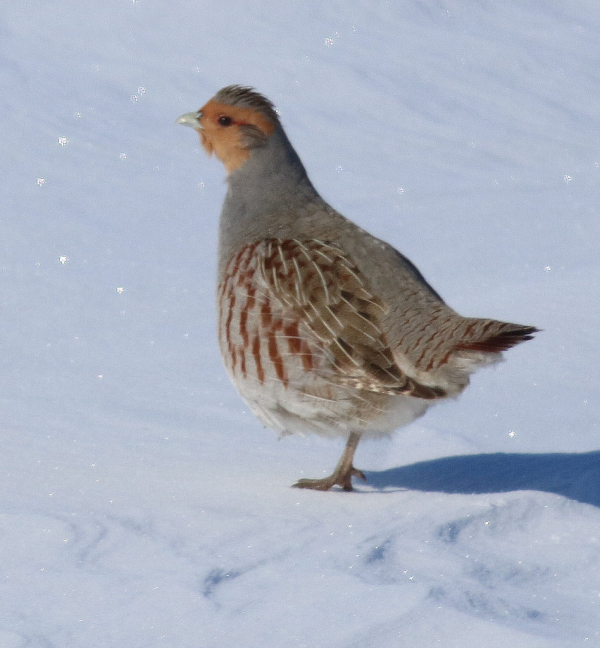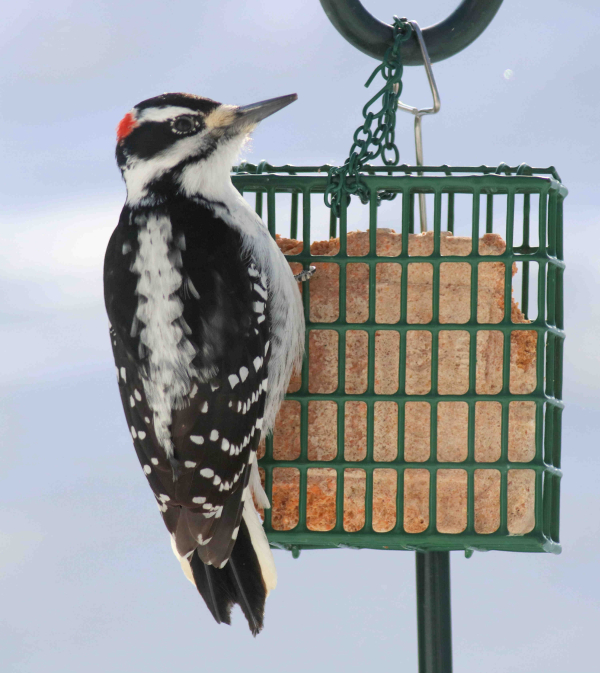
A Gray Partridge is a bird many birders travel to North Dakota to add to their life list, although Paul has seen very few during recent years. (You can even see the sun sparkles reflecting from the snow.)

A Gray Partridge is a bird many birders travel to North Dakota to add to their life list, although Paul has seen very few during recent years. (You can even see the sun sparkles reflecting from the snow.)
|
Cold spells are tough on birds, and on birders; but some days a field trip provides welcome surprises. Friday I drove an hour with little avian action, but when I least expected it, a covey of 14 Gray Partridges caught my eye as they huddled out of the wind on a windswept snowdrift. I haven’t seen partridges for a few months, and don’t have any photos of them in the snow, so it was exciting to see them and have a chance to photograph them. By the time I returned to the scene, the partridges had spread out, but I was able to photograph some individuals as they walked on top of the drift and made pleasing contact calls to one another.
I was on the way to Bismarck, and within a few miles of town I sighted an adult Golden Eagle perched in a bare cottonwood – not a common sight in that area, although I would expect to see a Bald Eagle, especially a little closer to the Missouri River. After an eventful meeting at the capitol, the sun popped out from behind an expanse of clouds, so I decided to look for Wild Turkeys along the wooded floodplain of the Missouri River for a half-hour. No turkeys, but I studied a flock of 40-plus Ring-necked Pheasants; Ring-necks are the dominant birds on the Dakota plains these days, as well as in the river floodplain.
Sunday afternoon, while driving west in search of birds, I noticed a large bird flying northward from a half-mile away. From that distance, judging by size my first impression was a Prairie Falcon, but it turned out to be much bigger, and whiter. By the time I approached closest to the bird, I could see it was a young Snowy Owl. It landed on a hilltop where it stood preening as I watched a few minutes. I haven’t been seeing many Snowys since mid-January, so it was fun to view this beautiful young owl, number 19 for this winter.
Farther down the road I sighted a pair of Great Horned Owls perched almost side by side on a branch – a pre-nesting behavior that will lead into the nesting season in two or three weeks. I checked the area for a vacant hawk nest, but didn’t see any obvious potential nest sites for the owls. There were a few scattered flocks of snow birds along the way, including Snow Buntings, Horned Larks, and Lapland Longspurs, but the most interesting sighting was on my return, within a mile of home.
It was another “barn owl,” a Great Horned Owl perched in an open barn window. Viewing the big owl from a considerable distance with my binoculars and camera lens, I could see that it was perched with its back facing outward – different, I thought. And there was an orange spot near the owl’s tail. At home, after enlarging the documentary photos I took on my computer screen, I saw the unusual orange “spot” below the owl was actually the tail of a fox squirrel, which the big owl may have caught moments before I spied it. Perhaps this was the same owl that was calling outside my house Monday evening.
Speaking of yard birds, I’m excited that I had a new visitor to my feeding station a week ago Sunday – a male Hairy Woodpecker that came to my suet feeder repeatedly. In fact, I took a photo of it that first day, which I used to illustrate last week’s Backyard Birding article. (OK, I’ll include it here too.) Up to Sunday, I have had a female Hairy Woodpecker visiting periodically, but now I have a male stopping in regularly each day too. No other changes for my yard birds, although it sure is different since the House Finches left en masse before, during, or after one of the blizzards. Hope your feeding station is providing some new sightings. Until next week, Aloha.
Article and photos by Paul Konrad
Share your bird sightings and photos at editorstbw2@gmail.com